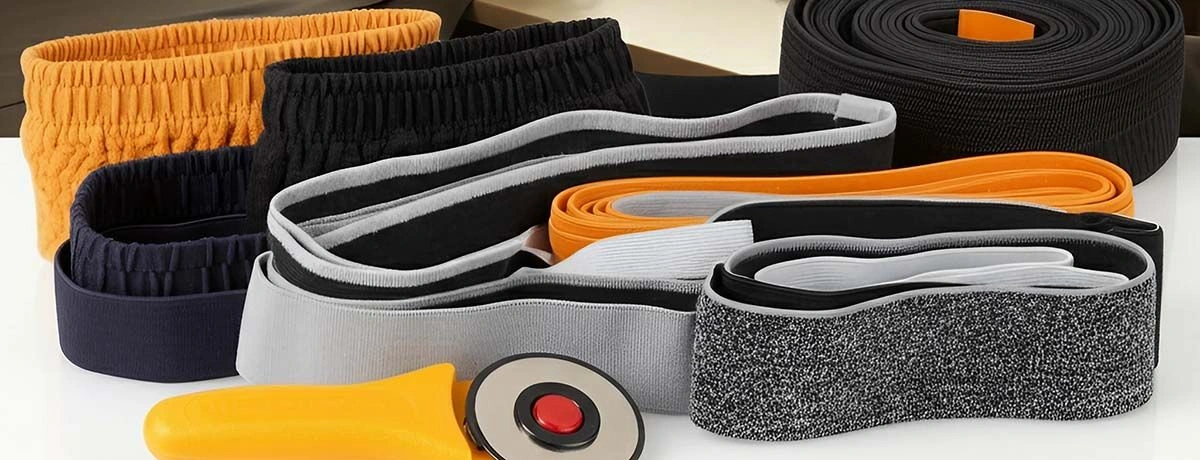The Definitive Guide to Choosing and Using Elastic Band for Pants

Elastic is a must have in modern garment production, comfort, style and flexibility for pants from tailored trousers to everyday joggers and sportswear. Whether you’re a garment manufacturer, textile trader or workwear or athleisure apparel specialist, choosing the right elastic for pants can make a big difference to the final product.
This guide covers everything you need to know about choosing and using elastic waistbands, including practical tips and tricks for incorporating them into your designs. Elastic bands are also perfect for DIY crafts, offering versatility for various projects such as DIY clothing and waistband-related crafts.
How to Choose the Right Elastic for Pants
Choosing the right elastic waistband is key to durability, comfort and aesthetics of your pants. Here’s what to consider.
Match Elastic Width and Thickness to Pant Style
The style of pant you’re designing will determine the width and thickness of the elastic and how they can be dressed up or down for various occasions. For example:
-
Trousers or chinos go with thin, invisible elastic.
-
Athleisure pants like joggers or leggings need wider elastic for support and comfort.
-
Workwear pants may need thicker, more robust elastic to withstand the wear and tear.
Choosing the right dimensions will ensure the elastic sits flat and supports the garment’s functionality.
Match Elastic to Fabric Weight
The weight and type of fabric—cotton, polyester or a blend—will guide your choice of elastic. For example:
-
Light fabrics like satin or lightweight polyester go with soft, thin elastic.
-
Denser fabrics like denim or canvas need heavy duty elastic bands that won’t lose shape over time.
Elasticity matched to fabric weight looks cohesive.
Stretch and Recovery
Elastic waistbands for pants need to balance stretch and recovery. Stretch is flexibility, recovery is the elastic bouncing back to its original shape. Look for elastic labelled as durable as this will ensure long term performance and reduce slack over time.
Colour and Texture
To add to the garment’s visual appeal choose elastics that match the pants’ colour and texture. Neutral colours like black, white and beige are versatile but bold colours or textured elastics can add a design element for casual or sporty wear.
Choose Soft and Breathable Materials
Comfort is key when designing pants for long wear. Soft breathable elastics will prevent the waistband from irritating the skin. Elastics made from soft polyester or spandex blends are perfect for sportswear and everyday wear.
How to Use Elastic for Pants
Now that you’ve chosen the right elastic, the next steps are measurement, cutting and stitching to get a flat and functional waistband. Follow these steps.
Measuring and Cutting Elastic
Measure Accurately
Measure the waistband of the pant pattern or the wearer’s natural waistline to determine the length of the elastic. Add a small margin for seam allowance for flexibility during stitching.
Use Right Tools
A rotary cutter and cutting mat are essential tools for clean and precise cuts. Good tools will also prevent frayed edges or uneven lengths.
Additionally, using a sewing machine is crucial for precise and secure stitching of the elastic.
Pre-Cut for Efficiency
For mass production in garment manufacturing, consider pre-cut elastic strips for time saving and uniformity across products.
Check Measurements
Always use a measuring tape or sewing ruler to double check lengths before moving on to the next step. Small mistakes in measurement will affect the overall fit and comfort of the garment.
Sewing Elastic Waistbands
Choose the Right Stitches
Zigzag or serger is the best stitch to use for sewing elastics to create durable and stretchy seams. These stitches will allow for flexibility and won’t break under tension.
Fold and Sew
For a clean finish:
-
Fold the elastic in half for extra structure.
-
Pin it to the fabric before sewing, ensuring the elastic is securely attached so it does not pull through during wear.
Use Right Equipment
Using a walking foot or Teflon foot on your machine will allow the elastic to slide smoothly under the presser foot without sticking or bunching.
Secure the Seam
Backstitch at both ends of the seam to prevent the elastic from coming undone during wear or washing.
Hidden Elastic Techniques
For a seamless finish:
-
Sew the elastic to the wrong side of the fabric.
-
Turn the fabric right side out, the elastic will be inside the waistband.
-
Use a blind hem stitch or stretch stitch for secure and invisible seams.
Variations and Options
Elastic waistbands are not one size fits all. Here are some creative alternatives and options for different garments.
-
Drawstring Waistbands: Combine an elastic waistband with a drawstring for an adjustable and stylish look.
-
Decorative Trims: Add ribbons or trims for a fashion forward waistband.
-
Mix Textures: Try contrasting textures or colors for a unique look.
-
Built-in Stretchy Fabric: Use a stretchy knit or spandex panel instead of elastic for a slimmer look.
-
Trim the Elastic: After installing the elastic waistband, trim the elastic to ensure it fits properly and secure the edges to prevent unraveling after washing.
Tips for Sewing Elastic Bands
And here are some expert tips for sewing elastic bands for pants:
-
Use a ballpoint or stretch needle to prevent snagging or skipped stitches when sewing elastic.
-
Get a stabilized elastic for added support in heavy garments like work pants.
-
Serge edges to prevent fraying especially for raw elastic ends.
-
Iron folds hot to flatten, for a finished waistband.
Upgrade Your Pants with Premium Elastic Waistbands
Elastic bands are the behind the scenes heroes of design, providing both function and fashion for pants in all types. By choosing the right elastic and using advanced sewing techniques, manufacturers can create garments that fit and last. Shop our collection of elastic waist pants to explore a variety of styles that offer both comfort and versatility.
For wholesale elastic for pants waistbands or to talk to us about your manufacturing needs, contact MH.
